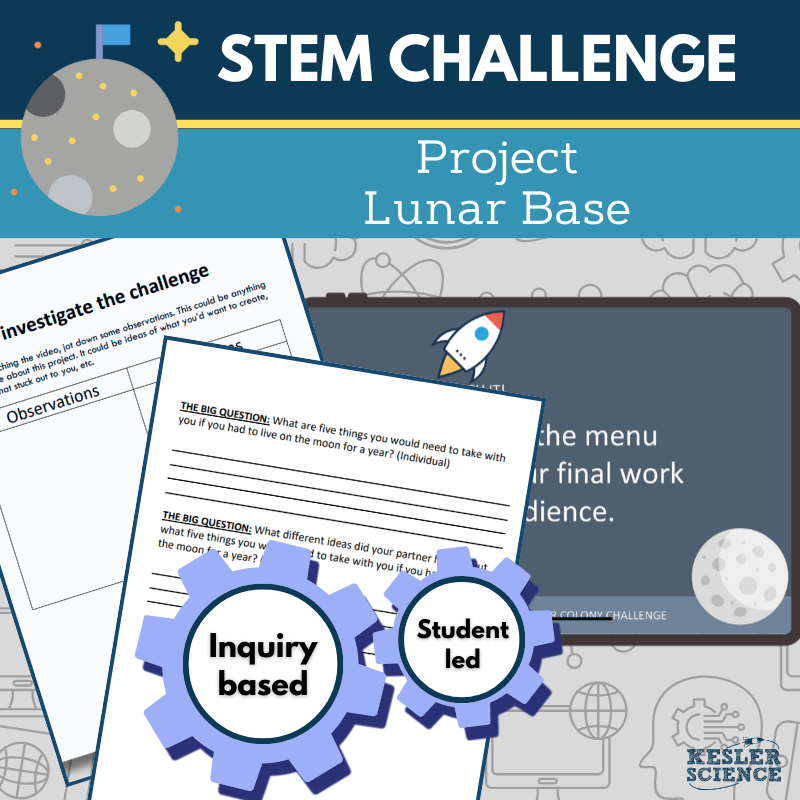
STEM Challenge - Project: Lunar Base - Design a Lunar Colony
Looking for a flexible, multi-day activity that gets your students “doing science?” Every STEM Challenge offers a hands-on, inquiry-based, student-led project designed to allow them to step into the roles of researchers and engineers.
STEM Challenge projects are ideal for use at any time throughout the school year, between units, before breaks, or during afternoons when testing weeks occur.
For teachers, there are presentations and step-by-step guides to facilitate pacing and lesson plans that align with standards. Students utilize the included notebooks to guide them through activities (both individually and in small groups), challenge them to learn new information, and reflect on and apply the information they have learned.
The Challenge:
In order to prove humans can create a sustainable habitat on other planets, NASA has decided to move forward with constructing a lunar base to test long-term survival outside of Earth's atmosphere. 4 astronauts will need to live in the lunar residence for 2 years. NASA created a national contest which will allow anyone in the country to submit a proposal for the project. The winning design will be used on the moon, and a million dollar prize will be awarded to the team.
The design does have to meet a few criteria.
- The perimeter of the lunar base cannot be more than 32 meters.
- The height of the base cannot be more than 3 meters
- The base will have to generate its own water, oxygen, and food supply.
- An airlock must be included in the design so that astronauts can leave the base for exploration.
Be sure to think about all the scenarios needed to sustain life. How will they stay fit in low gravity? What happens if they get sick? Where will trash go? How will they deal with the loneliness and possible depression that may set in over time? This is an exciting challenge and your team really wants that million dollar reward. It's time to get to work!
Things to consider: the effects of lunar life on the human bodies, sustainable food source, how to get supplies to the moon, how to handle waste, etc.
What’s in a STEM Challenge?
- a video explaining the engineering challenge and setting the context for the project
- a BIG Question to guide the inquiry
- teacher presentation in PPT (Google-compatible) and Keynote
- a teacher's guide on what the teacher and students should be doing along the way
- student notebook offers
- questions to provide the students with a framework for their inquiry throughout the entire project
- opportunities to absorb new information and reflect on ways to use it to complete the challenge
- Using the LAUNCH process, students brainstorm with their peers and reflect on failures and opportunities, with the prospect of sharing their ideas with the world. This holds students accountable, and they will put forth the best effort, knowing that other students could critique the project.
- Each STEM Challenge contains a list of suggested supplies for its project. We were very cautious about choosing inexpensive items, and the supply list is dynamic, allowing for adjustments to individual situations. Suggested supplies include:
- scissors
- glue
- tape
- cardboard
- paper
- graph paper
- markers
- different types of cups
- rubber bands
- pipe cleaners
- clay
- empty water bottles and tops
- bubble wrap
- brads
- paper clips
- paper plates
NGSS Standards
Aside from the engineering components of this project, students will be learning about perimeter, the future of space exploration, and the effects of space on the human body.
NGSS: MS-ETS1-1, MS-ETS1-2, MS-ETS1-3, MS-ETS1-4
Pickup currently not available
Terms of Use
Copyright © Kesler Science, LLC. All rights reserved by the author. This product is to be used by the original downloader only. Copying for more than one teacher, classroom, department, school, or school system is prohibited. Permission is never granted to enter Kesler Science materials into any form of AI for any purpose. This product may not be distributed or displayed digitally for public view. Failure to comply is
copyright infringement and a violation of the Digital Millennium Copyright Act (DMCA). Clipart and elements found in this PDF are
copyrighted and cannot be extracted and used outside of this file without permission or license. Intended for classroom and personal use ONLY. Multiple licenses are available for purchase by departments,
schools, or school districts. Contact support@keslerscience.com for more information.









